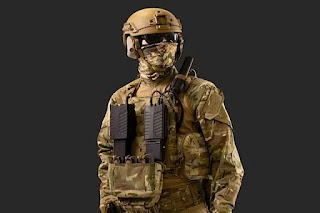US Military Adopts Lightweight Counter-Drone Devices from Danish Company MyDefence, Wearable on Army Vests
In July 2025, the U.S. Army formalized a $26 million contract with Danish defense technology firm MyDefence to procure 485 wearable counter-unmanned aerial systems (C-UAS), marking a significant development in the military’s approach to drone threat mitigation. This acquisition reflects a broader strategic shift toward decentralized and soldier-level force protection, particularly in response to the increasing prevalence of unmanned aerial systems (UAS) in modern combat environments.
 |
| MyDefence |
The wearable systems, collectively referred to as the Soldier-Kit, integrate two core components: the “Wingman” drone detector and the “Pitbull” jammer. Weighing approximately 1.3 kilograms, the kit is designed for portability and can be attached to tactical gear or concealed within combat uniforms. The Wingman provides real-time scanning capabilities, while the Pitbull delivers targeted jamming to disrupt hostile drone operations. This modular configuration allows for flexible deployment across various terrains and operational scenarios.
Initial deployments of the Soldier-Kit have already occurred within the U.S. European Command (EUCOM), including joint exercises in Germany. These field trials are part of a broader evaluation framework under the Army’s Transformation in Contact (TiC) initiative, which aims to integrate emerging technologies into frontline units. Although specific TiC units receiving the systems have not been disclosed, the Army has indicated that multiple Brigade Combat Teams (BCTs) and Multi-Domain Task Forces (MDTFs) will participate in the next phase of testing.
The decision to invest in wearable C-UAS technology is informed by operational lessons from previous conflicts, where fixed-site jamming stations proved less adaptable to dynamic battlefield conditions. The Soldier-Kit’s compact design and frequency agility address limitations observed in earlier deployments in Iraq and Afghanistan, where static systems struggled to counter evolving drone tactics. By enabling individual soldiers to detect and neutralize drones independently, the Army aims to enhance situational awareness and reduce reliance on centralized air defense assets.
This procurement also underscores the growing role of international defense collaboration. MyDefence’s selection as a supplier highlights the increasing integration of European defense technologies into U.S. military operations. The Danish firm has emphasized its commitment to long-term cooperation with U.S. stakeholders and plans to expand its North American operations to support contract fulfillment. The deal represents MyDefence’s largest order to date and positions the company as a competitive player in the global C-UAS market.
From a tactical perspective, the wearable systems are intended to counter a broad spectrum of drone threats, ranging from commercial quadcopters to weaponized UAVs. The modular nature of the Soldier-Kit allows for scalability and adaptation to different mission profiles. Compared to vehicle-mounted or base-centric solutions offered by other suppliers, the Danish system provides a distinct advantage in asymmetric warfare scenarios, where mobility and rapid response are critical.
Strategically, the Army’s investment signals an acknowledgment of the changing nature of aerial threats. As drone swarms and electronic warfare tactics become more prevalent, traditional air defense systems may face limitations in coverage and responsiveness. Equipping soldiers with individual counter-drone capabilities reflects a proactive approach to maintaining operational integrity in contested airspace. This shift also aligns with broader geopolitical considerations, as drone proliferation continues across regions such as Eastern Europe and the Indo-Pacific.
While the long-term impact of the Soldier-Kit deployment remains to be seen, the current contract sets a precedent for future acquisitions and technological integration. The Army’s emphasis on modular, wearable solutions suggests a continued focus on enhancing individual soldier capabilities in response to emerging threats. As testing and evaluation progress, further insights may emerge regarding the system’s effectiveness and potential for wider adoption across U.S. and allied forces.
The U.S. Army’s acquisition of MyDefence’s wearable counter-drone systems represents a notable evolution in military defense strategy. By prioritizing mobility, adaptability, and decentralized protection, the Army is positioning itself to confront the challenges posed by increasingly sophisticated and ubiquitous drone technologies. The Soldier-Kit initiative may serve as a foundational step toward redefining how ground forces engage with aerial threats in future conflict environments.





